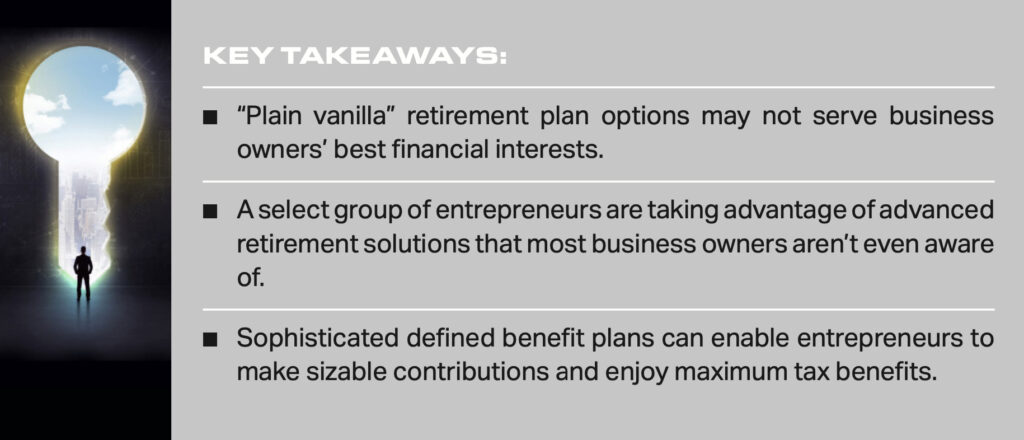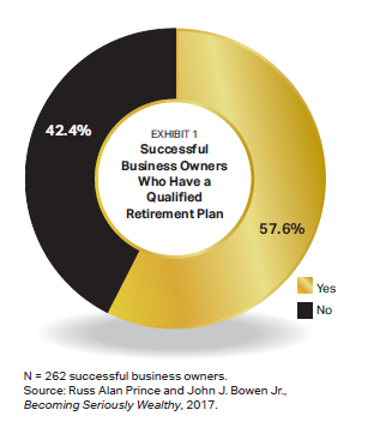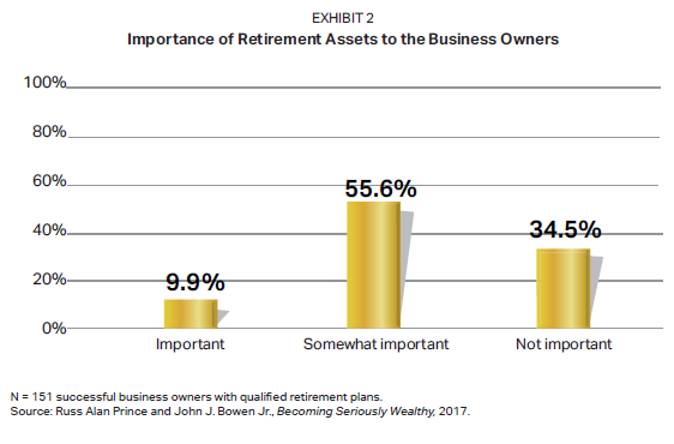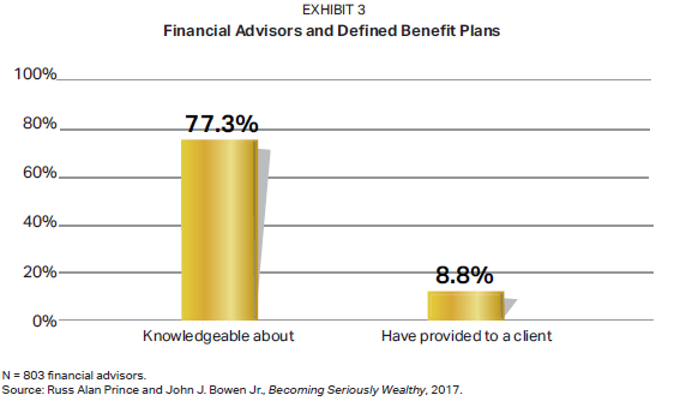Posted on: March 1st, 2018

Smart retirement planning can be an excellent way for successful business owners to enhance their wealth—sometimes significantly.
The problem: Most business owners are not using retirement plans nearly as effectively as they could be. They have “plain vanilla” solutions that do little to maximize personal wealth—and, as a result, they are missing out on opportunities to grow their assets.
In contrast, a relatively select group of entrepreneurs are tapping into the power of sophisticated retirement plans that can benefit them greatly.
It’s time to ask yourself: Should I join their ranks?
The first step to answering that question is to consider the retirement plans most business owners are familiar with: qualified retirement plans.
Qualified retirement plans are legal ways to shelter assets from taxes. You typically contribute pretax dollars and pay taxes only when you take funds out. The qualified plan provisions were put into the tax code to help motivate people to save for retirement.
The majority of successful business owners we surveyed are taking advantage of qualified retirement plans—although it is not an overwhelming majority (see Exhibit 1).

It may be that many of these owners have set up retirement plans mainly as a way to help attract and retain top-tier employees—not for their own benefit. Among those companies with qualified retirement plans, the amount of money that successful business owners can save in these plans tends not to be all that meaningful. As seen in Exhibit 2, only about one in ten business owners says these funds are “important” to them. About one-third say the monies are “not important.”

It’s clear to us that many business owners are not taking advantage of these retirement planning tools—and even among those who are, many aren’t getting what they should be getting from them.
The good news: There is a certain type of comparatively sophisticated qualified retirement plan that can be extremely beneficial to entrepreneurs in their quest to become seriously wealthy.
It’s the defined benefit plan.
Defined benefit plans promise a percentage of compensation to be received at retirement. That is, you (the business owner) will get a fixed percentage of your salary. As you become increasingly successful and generate larger amounts of discretionary (and taxable) cash flow, these plans can become quite attractive.
When set up optimally, defined benefit plans offer some attractive advantages to successful business owners whose businesses are generating ample cash flow:

Most financial advisors we surveyed reported being personally knowledgeable about defined benefit plans or having the appropriate retirement specialists on call (see Exhibit 3). But in stark contrast, only about 9 percent of the advisors have provided such plans to their business owner clients.

At the same time, a mere 18.3 percent of successful business owners—less than one-fifth—have set up defined benefit plans in their companies. That’s not a big surprise given how few financial advisors are actually providing these solutions—but it’s certainly not ideal.
Clearly, many business owners are not getting the advantages of defined benefit plans. One reason seems to be that the professionals with whom successful business owners work to manage their assets are not well enough versed in some of the nuances of this key area of wealth creation, or they lack the ability to effectively implement the most advantageous solutions.
While there are a number of different types of defined benefit plans, the following examples use a specialized version that maximizes the wealth of the business owners.[1]
A construction company with high cash flow and 51 employees was looking to implement a retirement plan that would considerably benefit the two owners—brothers age 51 and 44.
Of the 51 employees, 40 laborers were union (and therefore excluded from the plan). That left 11 office staff (including the owners) to be counted for pension planning purposes.
The company had an existing 401(k) with a profit-sharing component. In reviewing their options, one solution was to add a traditional defined benefit plan. Incorporating the traditional defined benefit plan, along with the 401(k) profit-sharing plan, would enable the company to make a total pretax contribution to the plan participants of $297,222. (Note: The minimum number of people who had to be covered were the two brothers and just four employees.)
Using a specialized defined benefit plan provided the brothers with $17,916 per month of lifetime income for themselves and their spouses. Each brother would also receive a life insurance benefit of $1,791,667. Approximately 90 percent of contributions funding the benefits from the specialized retirement plan would go to the two brothers.
A successful consulting firm with 17 employees had an existing defined benefit pension plan, along with a 401(k) profit-sharing plan. The owner, a woman age 72, had no intention of retiring. Additionally, her two children worked at the firm. The intention was that eventually the two children would take over the business.
The owner’s existing defined benefit plan was fully funded, so she was unable to make further contributions to the plan. The owner was looking to secure needed life insurance for her family financial planning, as well as to continue making tax-deductible contributions to her retirement plan.
By transitioning from the existing plan to a specialized defined benefit plan, the owner made a tax-deductible contribution of $5.6 million. The plan would provide almost $1.8 million in needed life insurance and continued retirement benefits, as well as fund future retirement benefits for her children—all on a pretax basis.
A private equity firm with partners and offices around the U.S. was looking for opportunities to help its owner-executives fund future retirement benefits on a pretax basis. The firm had 27 employees and seven owners.
In looking at retirement plan alternatives, the group reviewed the standard 401(k) profit-sharing plan as well as a cash balance plan. In structuring the plan and including the owner-executives as well as the necessary nonowner, non-highly compensated employees (nine people in total), the company would be able to put away approximately $1.5 million on a pretax basis through the 401(k) profit-sharing plan and the cash balance plan.
Using a specialized defined benefit plan that included those same seven owners and nine nonowner employees, it was determined the company could fund $5.1 million in year-one contributions toward the retirement plan. This plan would provide maximum retirement benefits for the executives (and their spouses) at retirement, while also providing a life insurance benefit of just under $1.8 million to their heirs.
If you think this approach to retirement planning may help you achieve your goals, contact your financial or legal professional.
[1] All examples are for illustrative purposes only and should not be relied upon when making any investment or tax planning decision. Always consult with an investment and/or tax professional prior to any decision to implement strategies similar to those illustrated.
This report was prepared by, and is reprinted with permission from, VFO Inner Circle. AES Nation, LLC is the creator and publisher of VFO Inner Circle reports.
Disclosure: The opinions expressed in this commentary are those of the author and may not necessarily reflect those held by Kestra IS or Kestra AS. The material is for informational purposes only. It represents an assessment of the market environment at a specific point in time and is not intended to be a forecast of future events, or a guarantee of future results. It is not guaranteed by Kestra IS or Kestra AS for accuracy, does not purport to be complete and is not intended to be used as a primary basis for investment decisions. It should also not be construed as advice meeting the particular investment needs of any investor. Neither the information presented nor any opinion expressed constitutes a solicitation for the purchase or sale of any security. Securities offered through Kestra Investment Services, LLC (Kestra IS), member FINRA/SIPC. Investment advisory services offered through Kestra Advisory Services, LLC (Kestra AS), an affiliate of Kestra IS.
Fusion Wealth Management is not affiliated with Kestra IS or Kestra AS. https://www.kestrafinancial.com/disclosures
VFO Inner Circle Special Report
By Russ Alan Prince and John J. Bowen Jr.
© Copyright 2021 by AES Nation, LLC. All rights reserved.
No part of this publication may be reproduced or retransmitted in any form or by any means, includ- ing, but not limited to, electronic, mechanical, photocopying, recording or any information storage retrieval system, without the prior written permission of the publisher. Unauthorized copying may subject violators to criminal penalties as well as liabilities for substantial monetary damages up to $100,000 per infringement, costs and attorneys’ fees.
This publication should not be utilized as a substitute for professional advice in specific situations. If legal, medical, accounting, financial, consulting, coaching or other professional advice is required, the services of the appropriate professional should be sought. Neither the authors nor the publisher may be held liable in any way for any interpretation or use of the information in this publication.
The authors will make recommendations for solutions for you to explore that are not our own. Any recommendation is always based on the authors’ research and experience.
The information contained herein is accurate to the best of the publisher’s and authors’ knowledge; however, the publisher and authors can accept no responsibility for the accuracy or completeness of such information or for loss or damage caused by any use thereof.
Unless otherwise noted, the source for all data cited regarding financial advisors in this report is CEG Worldwide, LLC. The source for all data cited regarding business owners and other professionals is AES Nation, LLC.